A Black Wool Mantle or Short Cloak,
1760-1775
1760-1775
The mantle (also called a mantelet or "plisse") was a short cloak that often had a shaped hemline. Extant examples and period prints and paintings suggest they were typically made of silk and/or lace, though it is likely wool and velvet could also have been used. They almost always had a hood. Mantles were somtimes trimmed with self-fabric, lace, fur, or another plush material, and served as a fashionable and functional accessory throughout most of the 18th century.
A delicate lace mantle worn decoratively over a pink silk gown.
Allan Ramsay's portrait of his second wife, Margaret Ramsay, 1755.
A fur-trimmed mantle.
The pattern: Costume Close-up, by Linda Baumgarten, pp. 50-53. The original is in the collection of Colonial Williamsburg's DeWitt Wallace Museum (acc. no. 1993-337). For a couple of original 1760s patterns and translated instructions from Garsault's L'art du tailleur, see this page from La Couturiere Parisienne.
The mantle laid flat, showing the shaped hemline and the half-circle
fullness characteristic of 18th century cloaks.
Construction Details: The mantle is entirely hand-sewn using some of the techniques described in Costume Close-up, though I had to alter the construction process slightly because my neckband only used two (rather than four) layers. The only alteration I made was to lengthen the body of the mantle 2 1/2" to make it ever-so-slightly warmer (if I had been making it out of lace, in other words, I would not have touched the length at all). Because my fabric wasn't wide enough, I had to piece the mantle's cape down the center back. The cape was then pleated to fit the neckband and attached using close backstitches. The wool hood and its lining were assembled separately; they were placed wrong sides together, and their edges turned under and secured using point a rabattre sous la main.
An interior view of the mantle. In keeping with extant wool cloaks, only
the hood is lined and the hem remains unfinished.
I then sewed the fan pleats at the back of the hood and stitched the hood to the neckband.
An interior view of the hood pleats. The silk lining and wool were
both turned under and finished before the pleating was done,
which creates the black center to the circle of the "fan."
Finally, all edges of the neckband lining pieces were folded under and it was sewn in using point a rabattre sous la main.
The silk lining of the hood and neckband.
The edges of the cloak's body are left unfinished, as is common for the longer broadcloth cloaks that survive from this period because the broadcloth is thick and firmly-woven enough to hold a clean(ish) edge.
The Fabric: To make this an accessory that is both fashionable and utilitarian, I opted to substitute black broachcloth for the silk and lace of the original (if only I could find lace worthy of a true reproduction!). Although all of the short cloaks and mantles known to survive are made of silk and/or lace or a cotton print (later in the century), wool was certainly used as well. Linda Baumgarten notes in Costume Close-up that Williamsburg milliners advertised short cloaks made of patterned material, black or white Persian, lace, and wool cloth in scarlet, purple, and black (see Costume Close-up, p. 51).
A view from the back. The mantle falls just below waist level.
The neckline, showing the wool tape ties and the elegant drape of the hood.
The cloak ties with black wool tapes. In keeping with extant full-length cloaks, the mantle's hood and neckband piece are lined in a thin creamy-white silk, while the mantle's cape remains unlined. The inspiration for Ashley's color choices is below.
An elegant black mantle (presumably silk taffeta), trimmed with
what appears to be black lace. The hood is lined in white.
The Pretty Mantua Maker, 1777. (from the Lewis Walpole Library,
for a fantastic zooming feature that shows off all the details!
A side view, showiung the shaped hemline draped up
slightly over the sleeve, as it would be when worn.



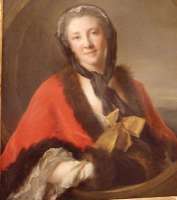

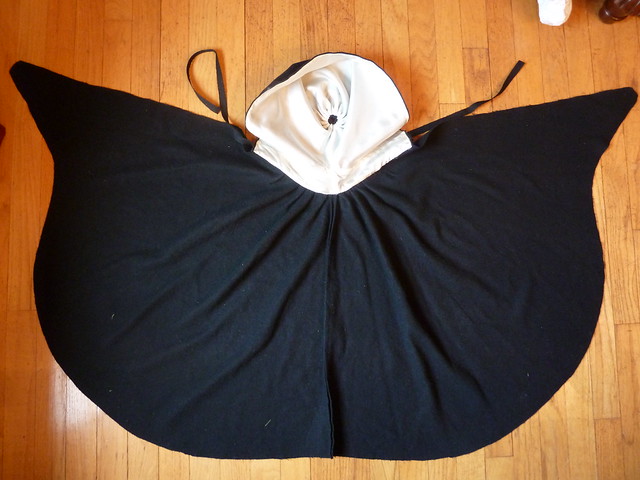
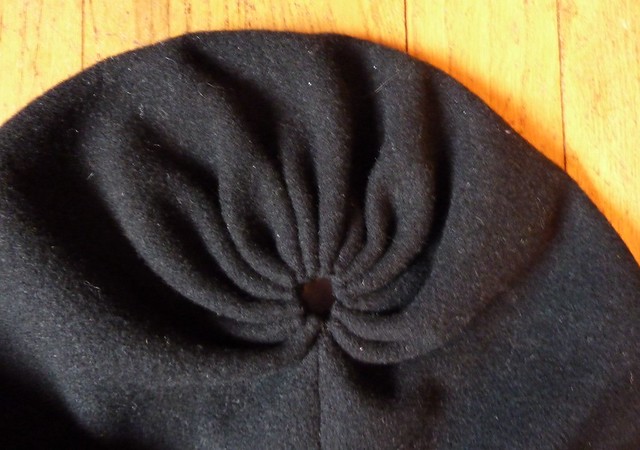
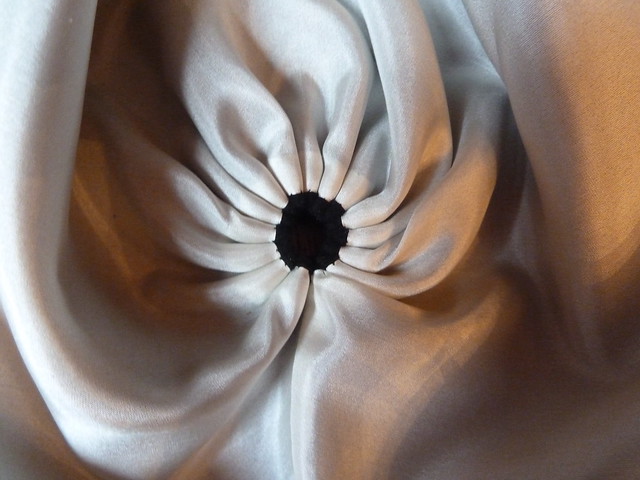
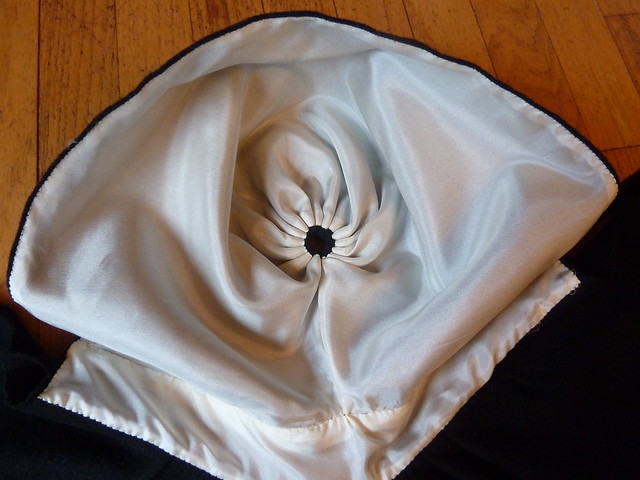

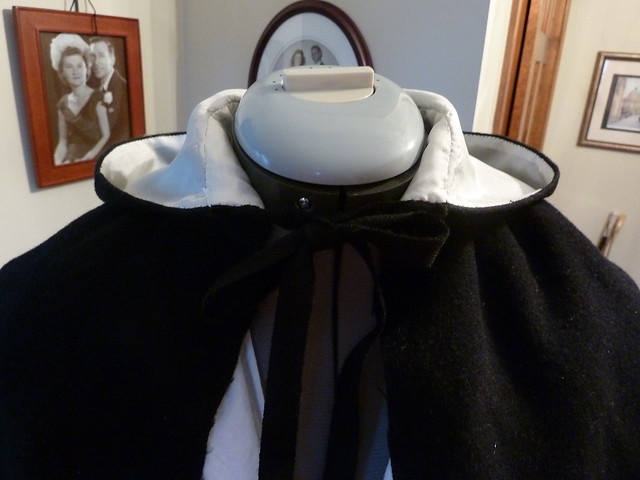
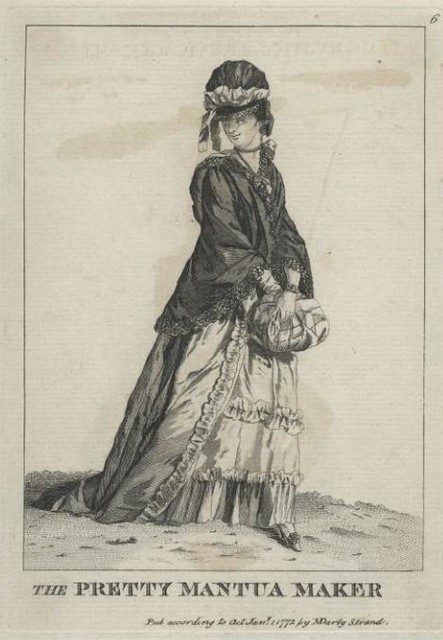
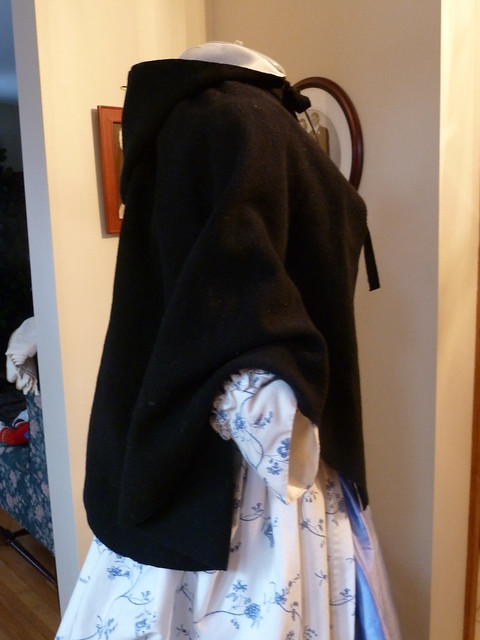
4 comments:
That looks really great! Love those pleats!
Laurie
Adorable! Inspiration for another project....don't you just love Costume Close-up?!
Thanks Laurie and Jenni! :-)
Jenni - I love the bonnet in your profile picture! The trimmings are so cute! Did you make it? Wherever did you find the hat blank? I really need to start expanding my Regency wardrobe!
Rebecca, Thank you, but no, I didn't make the bonnet in my picture. I was admiring one that I found at a Jane Austen Festival a couple of years ago. I have, however made my own capote style regency bonnet, using hemp braid from "The Dressmaker's Shop", here:
http://thedressmakersshop.netfirms.com/mystore/nfoscomm/catalog/index.php?osCsid=f39c678a04024941b37251e8073b4cb9
And you can see pictures of the finished bonnet on my blog:
here:
http://livingwithjane.blogspot.com/2010/06/my-accessories.html
and how I decorated it:
here:
http://livingwithjane.blogspot.com/2010/06/making-up-my-capote.html
It was a lot of fun!
I would like to see what you and your sister come up with when you decide to make a bonnet!
Post a Comment